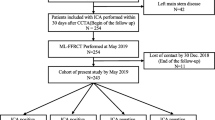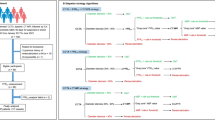Abstract
We evaluated the diagnostic performance of a deep-learning model (DLM) (CorEx®, Spimed-AI, Paris, France) designed to automatically detect > 50% coronary stenosis on coronary computed tomography angiography (CCTA) images. We studied inter-observer variability as an additional aim. CCTA images obtained before transcatheter aortic valve implantation (TAVI) were assessed by two radiologists and the DLM, and the results were compared to those of invasive coronary angiography (ICA) used as the reference standard. 165 consecutive patients underwent both CCTA and ICA as part of their TAVI work-up. We excluded the 42 (25.5%) patients with a history of stenting or bypass grafting and the 23 (13.9%) patients with low-quality images. We retrospectively subjected the CCTA images from the remaining 100 patients to evaluation by the DLM and compared the DLM and ICA results. All 25 patients with > 50% stenosis by ICA also had > 50% stenosis by DLM evaluation of CCTA: thus, the DLM had 100% sensitivity and 100% negative predictive value. False-positive DLM results were common, yielding a positive predictive value of only 39% (95% CI, 27–51%). Two radiologists with 3 and 25 years’ experience, respectively, performed similarly to the DLM in evaluating the CCTA images; thus, accuracy did not differ significantly between each reader and the DLM (p = 0.625 and p = 0.375, respectively). The DLM had 100% negative predictive value for > 50% stenosis and performed similarly to experienced radiologists. This tool may hold promise for identifying the up to one-third of patients who do not require ICA before TAVI.




Similar content being viewed by others
Abbreviations
- BMI:
-
Body mass index
- CAD:
-
coronary artery disease
- CAD-RADS:
-
Coronary artery disease-reporting and data system
- CCTA:
-
Coronary computed tomography angiography
- CT:
-
Computed tomography
- CX:
-
Circumflex artery
- DLM:
-
Deep learning model
- ECG:
-
Electrocardiogram
- ICA:
-
Invasive coronary angiography
- LAD:
-
Left anterior descending artery
- LVEF:
-
Left ventricular ejection fraction
- MPR:
-
Multiplanar reformation
- NPV:
-
Negative predictive value
- PPV:
-
Positive predictive value
- RCA:
-
Right coronary artery
- TAVI:
-
Transcatheter aortic valve implantation
References
Leon MB, Smith CR, Mack MJ, Makkar RR, Svensson LG, Kodali SK, Thourani VH, Tuzcu EM, Miller DC, Herrmann HC, Doshi D, Cohen DJ, Pichard AD, Kapadia S, Dewey T, Babaliaros V, Szeto WY, Williams MR, Kereiakes D, Zajarias A, Greason KL, Whisenant BK, Hodson RW, Moses JW, Trento A, Brown DL, Fearon WF, Pibarot P, Hahn RT, Jaber WA, Anderson WN, Alu MC, Webb JG (2016) PARTNER 2 investigators. Transcatheter or Surgical aortic-valve replacement in Intermediate-Risk patients. N Engl J Med 374(17):1609–1620. https://doi.org/10.1056/NEJMoa1514616»
Smith CR et al (2011) Transcatheter versus surgical aortic-valve replacement in high-risk patients. N Engl J Med 364(23):2187–2198. https://doi.org/10.1056/NEJMoa1103510
Vahanian A, Beyersdorf F, Praz F, Milojevic M, Baldus S, Bauersachs J, Capodanno D, Conradi L, De Bonis M, De Paulis R, Delgado V, Freemantle N, Gilard M, Haugaa KH, Jeppsson A, Jüni P, Pierard L, Prendergast BD, Sádaba JR, Tribouilloy C, Wojakowski W (2022) ESC/EACTS Scientific Document Group. 2021 ESC/EACTS Guidelines for the management of valvular heart disease. Erratum in: Eur Heart J. 2022 Feb 18; 632, Eur Heart J 43(7):561–632. https://doi.org/10.1093/eurheartj/ehab395
Pibarot P et al (2020) Echocardiographic Results of Transcatheter Versus Surgical Aortic Valve Replacement in Low-Risk Patients: The PARTNER 3 Trial Circulation 141(19):1527–1537. https://doi.org/10.1161/CIRCULATIONAHA.119.044574
Popma JJ et al (2019) Transcatheter Aortic-Valve Replacement with a Self-Expanding Valve in Low-Risk Patients. N Engl J Med 380(18):1706–1715. https://doi.org/10.1056/NEJMoa1816885
Gatti M, Gallone G, Poggi V, Bruno F, Serafini A, Depaoli A, De Filippo O, Conrotto F, Darvizeh F, Faletti R, De Ferrari GM, Fonio P, D’Ascenzo F (2022) Diagnostic accuracy of coronary computed tomography angiography for the evaluation of obstructive coronary artery disease in patients referred for transcatheter aortic valve implantation: a systematic review and meta-analysis. Eur Radiol 32(8):5189–5200. https://doi.org/10.1007/s00330-022-08603-y
D’Ascenzo F, Verardi R, Visconti M, Conrotto F, Scacciatella P, Dziewierz A, Stefanini GG, Paradis JM, Omedè P, Kodali S, D’Amico M, Rinaldi M, Salizzoni S (2018) Independent impact of extent of coronary artery disease and percutaneous revascularisation on 30-day and one-year mortality after TAVI: a meta-analysis of adjusted observational results. EuroIntervention 14(11):e1169–e1177. https://doi.org/10.4244/EIJ-D-18-00098
Witberg G, Regev E, Chen S, Assali A, Barbash IM, Planer D, Vaknin-Assa H, Guetta V, Vukasinovic V, Orvin K, Danenberg HD, Segev A, Kornowski R (2017) The Prognostic effects of Coronary Disease Severity and completeness of revascularization on mortality in patients undergoing transcatheter aortic valve replacement. JACC Cardiovasc Interv 10(14):1428–1435. https://doi.org/10.1016/j.jcin.2017.04.035
Otto CM et al (2021) 2020 ACC/AHA Guideline for the Management of Patients With Valvular Heart Disease: A Report of the American College of Cardiology/American Heart Association Joint Committee on Clinical Practice Guidelines Circulation 143(5):e25. https://doi.org/10.1161/CIR.0000000000000923
Bax JJ, Delgado V, Hahn RT, Leipsic J, Min JK, Grayburn P, Sondergaard L, Yoon SH, Windecker S (2020) Transcatheter aortic valve replacement: role of Multimodality Imaging in Common and Complex clinical scenarios. JACC Cardiovasc Imaging 13(1 Pt 1):124–139. https://doi.org/10.1016/j.jcmg.2018.10.037
Van den Boogert TPW, Claessen BEPM, Opolski MP, Kim WK, Hamdan A, Andreini D, Pugliese F, Möllmann H, Delewi R, Baan J, Vis MM, van Randen A, van Schuppen J, Stoker J, Henriques JP, Planken RN (2022) DEtection of ProxImal Coronary stenosis in the work-up for transcatheter aortic valve implantation using CTA (from the DEPICT CTA collaboration). Eur Radiol 32(1):143–151. https://doi.org/10.1007/s00330-021-08095-2
Malebranche D, Hoffner MKM, Huber AT, Cicovic A, Spano G, Bernhard B, Bartkowiak J, Okuno T, Lanz J, Räber L, Praz F, Stortecky S, Windecker S, Pilgrim T, Gräni C (2022) Diagnostic performance of quantitative coronary artery disease assessment using computed tomography in patients with aortic stenosis undergoing transcatheter aortic-valve implantation. BMC Cardiovasc Disord 22(1):178. https://doi.org/10.1186/s12872-022-02623-8
Muscogiuri G, Chiesa M, Trotta M, Gatti M, Palmisano V, Dell’Aversana S, Baessato F, Cavaliere A, Cicala G, Loffreno A, Rizzon G, Guglielmo M, Baggiano A, Fusini L, Saba L, Andreini D, Pepi M, Rabbat MG, Guaricci AI, De Cecco CN, Colombo G, Pontone G (2020) Performance of a deep learning algorithm for the evaluation of CAD-RADS classification with CCTA. Atherosclerosis 294:25–32. https://doi.org/10.1016/j.atherosclerosis.2019.12.001
Paul JF, Rohnean A, Giroussens H, Pressat-Laffouilhere T, Wong T (2022) Evaluation of a deep learning model on coronary CT angiography for automatic stenosis detection. Diagn Interv Imaging 103(6):316–323. https://doi.org/10.1016/j.diii.2022.01.004
Hong Y, Commandeur F, Cadet S, Goeller M, Doris MK, Chen X, Kwiecinski J, Berman DS, Slomka PJ, Chang HJ, Dey D (2019) Deep learning-based stenosis quantification from coronary CT angiography. Proc SPIE Int Soc Opt Eng 10949:109492I. https://doi.org/10.1117/12.2512168
Zreik M, van Hamersvelt RW, Wolterink JM, Leiner T, Viergever MA, Isgum I (2019) A recurrent CNN for Automatic Detection and classification of coronary artery plaque and stenosis in coronary CT angiography. IEEE Trans Med Imaging 38(7):1588–1598. https://doi.org/10.1109/TMI.2018.2883807
Francone M, Budde RPJ, Bremerich J, Dacher JN, Loewe C, Wolf F, Natale L, Pontone G, Redheuil A, Vliegenthart R, Nikolaou K, Gutberlet M, Salgado R (2020) CT and MR imaging prior to transcatheter aortic valve implantation: standardisation of scanning protocols, measurements and reporting-a consensus document by the European Society of Cardiovascular Radiology (ESCR). Eur Radiol 30(5):2627–2650. Epub 2019 Sep 5. Erratum in: Eur Radiol. 2020 Mar 2. https://doi.org/10.1007/s00330-019-06357-8
Achenbach S, Delgado V, Hausleiter J, Schoenhagen P, Min JK, Leipsic JA (2012) SCCT expert consensus document on computed tomography imaging before transcatheter aortic valve implantation (TAVI)/transcatheter aortic valve replacement (TAVR). J Cardiovasc Comput Tomogr 6(6):366–380. https://doi.org/10.1016/j.jcct.2012.11.002
El-Menyar AA, Suwaidi JA, Holmes DR (2007) Left Main Coronary Artery Stenosis: State-of-the-Art. Curr Prob Cardiol 32(3):103–193. https://doi.org/10.1016/j.cpcardiol.2006.12.002
Landis JR, Koch GG (1977) The measurement of observer agreement for categorical data. Biometrics 33(1):159–174. https://doi.org/10.2307/2529310
Kotronias RA et al (2017) Transcatheter aortic valve implantation with or without percutaneous coronary artery revascularization strategy: a systematic review and meta‐analysis. JAHA 6(6):e005960. https://doi.org/10.1161/JAHA.117.005960
Lateef N et al (2019) Meta-analysis comparing outcomes in patients undergoing transcatheter aortic valve implantation with versus without percutaneous coronary intervention Am J Cardiol 124(11):1757–1764. https://doi.org/10.1016/j.amjcard.2019.08.024
Weferling M, Hamm CW, Kim WK (2021) Percutaneous coronary intervention in transcatheter aortic valve implantation patients: overview and practical management. Front Cardiovasc Med 8:653768. https://doi.org/10.3389/fcvm.2021.653768
Sá MP, Sun T, Fatehi Hassanabad A, Awad AK, Van den Eynde J, Malin JH, Sicouri S, Torregrossa G, Ruhparwar A, Weymann A, Ramlawi B (2022) Complete transcatheter versus complete surgical treatment in patients with aortic valve stenosis and concomitant coronary artery disease: study-level meta-analysis with reconstructed time-to-event data. J Card Surg 37(7):2072–2083. https://doi.org/10.1111/jocs.16511
Cademartiri F, Maffei E, Palumbo AA, Malagò R, La Grutta L, Meiijboom WB, Aldrovandi A, Fusaro M, Vignali L, Menozzi A, Brambilla V, Coruzzi P, Midiri M, Kirchin MA, Mollet NR, Krestin GP (2008) Influence of intra-coronary enhancement on diagnostic accuracy with 64-slice CT coronary angiography. Eur Radiol 18(3):576–583. https://doi.org/10.1007/s00330-007-0773-0
Funding
The authors have not disclosed any funding.
Author information
Authors and Affiliations
Contributions
B.M. study design; collected data ; wrote the main manuscript ; prepared figures and tables ; reviewed the manuscript K.M. ; A.M. ; N.A. ; A.V. study design; collected data ; reviewed the manuscript C.DG. performed the statistical analysis ; reviewed the manuscript JF.P. ; reviewed the manuscript.
Corresponding author
Ethics declarations
Competing interests
Dr Jean-François Paul is founder and CEO of Spimed-AI.
Additional information
Publisher’s Note
Springer Nature remains neutral with regard to jurisdictional claims in published maps and institutional affiliations.
Supplementary Information
Below is the link to the electronic supplementary material.
Rights and permissions
Springer Nature or its licensor (e.g. a society or other partner) holds exclusive rights to this article under a publishing agreement with the author(s) or other rightsholder(s); author self-archiving of the accepted manuscript version of this article is solely governed by the terms of such publishing agreement and applicable law.
About this article
Cite this article
Mehier, B., Mahmoudi, K., Veugeois, A. et al. Diagnostic performance of deep learning to exclude coronary stenosis on CT angiography in TAVI patients. Int J Cardiovasc Imaging (2024). https://doi.org/10.1007/s10554-024-03063-5
Received:
Accepted:
Published:
DOI: https://doi.org/10.1007/s10554-024-03063-5




